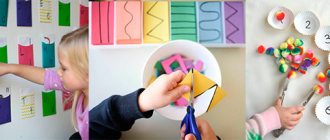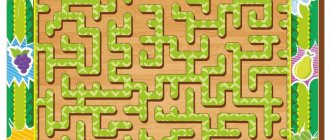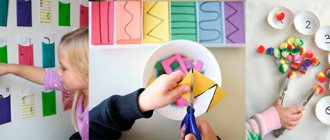“We walked in Africa” (game for children 5–7 years old)
Children stand in a circle or scattered.
The teacher shows the movements and pronounces the text, the children repeat the movements.
We walked around Africa (Stamp our feet.) And collected bananas. (They depict how they collect bananas.) I’ll give it to mom, I’ll give it to dad (We knock on the right knee, then on the left.) And we won’t deprive ourselves. (We knock on the chest with our right and left hands.) Suddenly a huge gorilla (We draw a large circle with our hands.) Almost crushed me. (We knock on the chest with our right and left hands.) I’ll give it to mom, I’ll give it to dad (Knock on the right, then the left knee.) And I won’t deprive myself. (Knock on the chest with our right and left hands.)
Card index of sedentary games in kindergarten
Games based on folklore material are played with younger pupils. It is recommended to use musical accompaniment for sedentary games: instrumental melodies at a slow tempo, folk songs, recordings of nature sounds.
Older preschoolers often play outdoor games during independent study. A musical background also helps to orient them in the need to transition from high-intensity play to sedentary play. The music sounds at a fast pace - the games are appropriate, the music is slow - it’s time to play more calmly.
The selection of games presented below is based on the program by N. E. Veraksa “From birth to school” and the methodological manual by O. E. Gromova “Outdoor games for children of the Federal State Educational Standard for Education”.
The game must correspond to the age and interests of the students
Games for children 1.5–4 years old
In the first and second junior groups, the following sedentary games are recommended:
- “All the kittens washed their paws”;
- “Where are the pens”;
- “Once upon a time there were bunnies”;
- "Bunny";
- "Carousels";
- “The cat came to the stove”;
- “The cat lets out its claws”;
- "Ladushki";
- “It flies - it doesn’t fly”;
- “Mice and the Cat”/“Tsapki” (option where the mice are the children’s fingers);
- "Find a toy";
- "Find your color";
- “Two met...”;
- "Blow up, bubble";
- "Sun and Rain";
- "Silence";
- “Don’t wake the bear!”;
- “Cold - warm”;
- "Humpty Dumpty";
- “The king walked through the forest”;
- “These are eyes, here, here!”
Examples of collections of games with detailed descriptions for pupils of younger groups:
- Card index of sedentary games in the first junior group (Sorokina T.S.);
- Games of low mobility with children of the second younger group (Tararukhina T.V.).
Photo gallery: examples of cards with game descriptions
Game “Where are the pens?” designed for very young children, it is recommended to play it first in subgroups of 2-3 people
The game "Bunny" develops gross motor skills of children
“Ladushki” is learned in pairs: a child and a teacher
The game “The Rain Came Out for a Walk” develops reaction speed and fine motor skills
The game “Find Your Color” develops children’s attention
“Blow up, bubble!” - a popular game in preschool educational institutions, it is played during classes, holidays, walks
In the game “Sunshine and Rain”, children move rhythmically and learn to play with an attribute (umbrella)
Children practice walking in a column in the game “Silence”
Toy search games develop children's attention
Ri is performed in the form of a round dance with movements according to the text
The game based on the poem “Humpty Dumpty” is aimed at relieving muscle tension
Games for children 4–7 years old
With pupils of the middle, senior and preparatory groups, you can conduct a variety of sedentary games, including:
- "Rope";
- "Balloon";
- “Where did you knock?”;
- "Prohibited movement";
- "Mirror";
- "How are you?";
- "Dwarfs and Giants";
- “Who is missing?”;
- "Ring";
- “Who am I in the family?”;
- "Linen";
- "Slow Turtle"
- “The sea is rough!”;
- "Find yourself a partner";
- “Find and remain silent”;
- “You can’t see anything”;
- “Nose-ear-nose”;
- "On the path";
- "Trip to Moscow";
- “Edible-inedible”;
- "Three movements";
- "Weathervane"/"Four Elements";
- "Ball".
An example of a card index of games for older preschoolers can be seen here (author - O. S. Syapkaeva).
Photo gallery: cards with game descriptions
The game “Rope” promotes the development of beautiful posture and the development of a sense of balance
The game “Fishing Rod” develops attentiveness and reaction speed, trains in jumping on the spot
The Balloon game develops speech and motor skills at the same time.
By playing Mirror, children develop attentiveness
The game “Forbidden Movement” develops auditory attention and memory
In the game “How are you living?” children are given freedom to depict movements in the text
"Dwarves and Giants" - another fun game for attentiveness and reaction speed
There are different versions of the game “Ring”; in the sedentary version, the person who receives the ring does not need to run away
“The Sea is Rising” is one of the most popular low-mobility games
In the calm version of the game “Find Yourself a Mate,” running is replaced by walking
In the game “On a Level Path,” children improve their ability to coordinate movements with text
There is probably no child who does not know the game “Edible-Inedible”
The game “Four Elements” uses numbers to replace words, which activates children’s mental activity
“Who am I in the family?” - an example of a combination of a cognitive element in an outdoor game
The game “Find and remain silent” is often played at the final stage of a physical education lesson.
“Ball” (game for children 5–7 years old)
Children stand in a circle or scattered.
The teacher shows the movements and pronounces the text, the children repeat the movements.
Ten, nine, (Clap their hands.) Eight, seven, (Slap their knees.) Six, five, (Clap.) Four, three, (Slap.) Two, one. (They clap.) We are with the ball (They cover their eyes with either the inside or the outside of their palm.) We want to play. We just need to find out: (They clap for every word.) Who will have the ball (They stomp for every word.) Catch up. (They squat.)
“Five Names” (game for children 5–7 years old)
Children are divided into two teams.
Two players, a boy and a girl (representatives of two teams), stand next to each other in front of two lines.
At the signal, they must walk forward (first one, then the other), taking five steps, and for each step, without the slightest error or hesitation (without breaking the rhythm), pronounce a name (boys - the names of girls, girls - the names of boys). This is a seemingly simple task, but in reality it is not so easy to complete.
You can name five other words (animals, plants, household items, etc.). There are many names, but not everyone can pick up five names and pronounce them one after another without delay in the rhythm of a step.
The winner is the one who copes with this task or is able to name more names.
“Three, thirteen, thirty” (game for children 5–7 years old)
They choose a driver. The players stand in a circle and open with outstretched arms. The driver stands in the center of the circle. When playing the game for the first time, it is advisable that the teacher be the driver.
The teacher explains that if he says: “Three,” all the players put their hands to the sides; if he says: “Thirteen,” everyone puts their hands on their belts; if he says: “Thirty” - everyone raises their hands up (you can choose any movements).
The teacher quickly names one movement or another. The player who made a mistake sits on the floor. When 1-2 players remain in the circle, the game ends; The winners are announced.
Carrying out sedentary games in kindergarten
Low mobility games in preschool educational institutions are organized several times during the day:
- in the final part of a physical education lesson or leisure time, in order to bring the pupils into a relatively calm state;
- on a walk after helping with cleaning or beautifying the area, after high mobility play;
- in the middle of a cognitive and artistic lesson to relieve mental and muscle tension;
- outside routine moments: after a walk, after cleaning a group room, during quiet activities in the afternoon;
- at matinees and holidays.
Low mobility games are held during thematic leisure time
The teacher selects low-mobility games in advance in accordance with the age of the children and the topic of the lesson (leisure activity). If a teacher plans to play a new game with children, he must first learn the rules and text accompaniment of the game, and remember the movements. It is unacceptable to read the contents of the game from the sheet! It is allowed to show children a short video of how this game plays out (no longer than 1 minute), and offer to get acquainted with the rules. The teacher's emotional story about the game wins children over and motivates them.
The teacher passes on his own gaming experience to the children, teaches the children what he himself can do.
Table: stages of sedentary play
| Stage of the game | Junior groups | Middle, senior, preparatory groups |
| Gathering for the game |
| |
| Introductory stage, motivating beginning |
| |
| Explanation | The teacher explains the game during its implementation: shows the movements, gives a signal to change actions. |
|
| A game |
|
|
| Completion |
|
|
Duration of sedentary games
The duration of the game from the moment the participants gather is determined taking into account the age of the children:
- in younger groups - no more than 10 minutes;
- on average - 12 minutes;
- in senior and preparatory classes - 15 minutes.
Table: time plan for the game “Sunshine and Rain” in the first junior group
| Stage of the game | Collection and introductory stage: receiving a parcel with an umbrella | Explanation of the rules | A game | Completion: the teacher takes a photo of the children with an umbrella to send in an envelope to the fabulous sender of the parcel |
| Duration | 1 minute | 1 minute | 4 minutes | 1 minute |
The guys learn a new attribute and learn to play with it during their first acquaintance with the game “Sunshine and Rain”
Table: time plan of the game “The sea is agitated, once!” in the middle group
| Stage of the game | Gathering and introductory stage: King Neptune comes to visit the guys | Explanation of the rules | A game | Completion: Neptune talks to the guys about how they liked the sea game |
| Duration | 1 minute | 2 minutes | 6–7 minutes | 2 minutes |
In the game “The Sea Is Worried”, children not only strike poses, but also fantasize about how they can imagine a sea animal
Table: time plan for the game “Flies - doesn’t fly” in the senior group
| Stage of the game | Collection and introductory stage: letter from insects from a fairy-tale forest (pictures of all animals and objects that consider themselves to fly) | Explanation: conversation about questions about the rules of a familiar game | A game | Completion: the guys make up an answer to the insects, attaching cards of flying objects |
| Duration | 2 minutes | 2 minutes | 7–8 minutes | 2 minutes |
The game “Flies - doesn’t fly” consolidates children’s knowledge about objects in the world around them
Table: example of a summary of a low-mobility game for children 5–6 years old
| Author | Nutikova E., teacher at MBDOU D/s No. 198, Novokuznetsk, Kemerovo region. |
| Name | "Amanita" |
| Purpose of the game |
|
| Preparing for the game |
|
| Material | A cone made of plastic or cardboard 40–50 cm high, to the top of which is attached a circle of red cardboard with specks drawn on it in white gouache (circle diameter 10–15 cm). |
| Progress of the game |
|
| Quote from: https://www.maam.ru/detskijsad/podvizhnaja-igra-maloi-podvizhnosti-muhomor.html | |
The following outline outline describes the main stages of organizing and conducting outdoor games with preschoolers.
Advantages of development:
- description of the production of gaming material (fly agaric);
- adding a more complicated version of the game;
- indicating at the final stage of the game the transition to independent creative activity (drawing with crayons).
The shortcoming of the notes is seen in one of the goals set for the game: “development of musical ear and perception.” It is not clear how ear for music develops during the described game. Children recite poetic text, but no songs are sung. The author does not mention the use of musical accompaniment. The use of a tambourine cannot be considered a musical element, as a prohibiting signal is given according to the rules of the game.
For the round dance game “Fly Agaric”, G. Vikhareva’s song “Fly Agaric Mushrooms” can be used.











